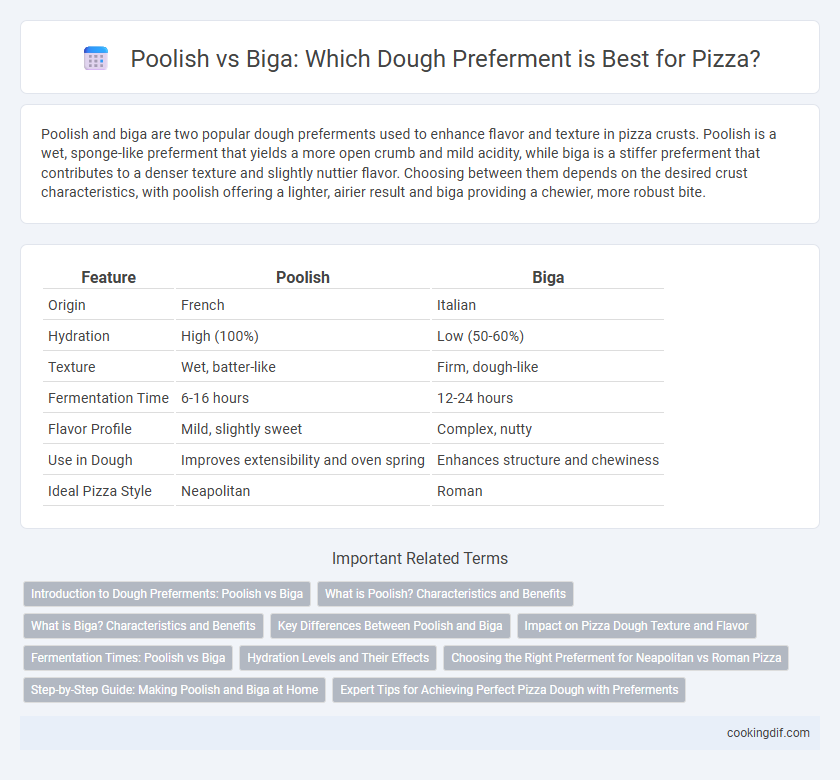Poolish and biga are two popular dough preferments used to enhance flavor and texture in pizza crusts. Poolish is a wet, sponge-like preferment that yields a more open crumb and mild acidity, while biga is a stiffer preferment that contributes to a denser texture and slightly nuttier flavor. Choosing between them depends on the desired crust characteristics, with poolish offering a lighter, airier result and biga providing a chewier, more robust bite.
Table of Comparison
| Feature | Poolish | Biga |
|---|---|---|
| Origin | French | Italian |
| Hydration | High (100%) | Low (50-60%) |
| Texture | Wet, batter-like | Firm, dough-like |
| Fermentation Time | 6-16 hours | 12-24 hours |
| Flavor Profile | Mild, slightly sweet | Complex, nutty |
| Use in Dough | Improves extensibility and oven spring | Enhances structure and chewiness |
| Ideal Pizza Style | Neapolitan | Roman |
Introduction to Dough Preferments: Poolish vs Biga
Poolish and biga are traditional Italian dough preferments used to enhance flavor, texture, and fermentation in pizza dough. Poolish, a wet sponge with equal parts flour and water by weight, creates a light, open crumb and subtle acidity, while biga, a stiffer preferment with less hydration, adds elasticity, complex flavor, and a chewy texture. Both preferments improve dough extensibility and yeast activity, with the choice depending on desired crust characteristics and fermentation time.
What is Poolish? Characteristics and Benefits
Poolish is a type of preferment used in pizza dough, originating from French baking techniques, characterized by a wet, batter-like consistency with equal parts water and flour by weight and a small amount of yeast. This preferment develops enhanced flavor complexity and improved dough elasticity through extended fermentation, contributing to a lighter, airier pizza crust. Using Poolish also increases dough hydration and enzyme activity, which aids in better gluten development and results in a more open crumb structure.
What is Biga? Characteristics and Benefits
Biga is a traditional Italian dough preferment made with flour, water, and a small amount of yeast, known for its stiff consistency compared to the wetter Poolish. Its characteristics include slow fermentation, which enhances gluten development and produces a complex, slightly nutty flavor ideal for artisanal pizza crusts. Using Biga improves dough strength, fermentation control, and results in a crispier texture with a more open crumb structure.
Key Differences Between Poolish and Biga
Poolish is a high-hydration preferment with equal parts flour and water, resulting in a batter-like consistency that enhances dough extensibility and flavor complexity. Biga, originating from Italian baking, is a stiff preferment with lower hydration, typically around 50-60%, which contributes to a stronger gluten structure and a chewier crust. Both poolish and biga improve fermentation and dough strength, but poolish tends to yield a lighter crumb while biga provides denser texture and more pronounced sourdough notes.
Impact on Pizza Dough Texture and Flavor
Poolish, a wet preferment with high hydration, promotes a light, airy pizza crust with a delicate crumb and slightly tangy flavor due to extended fermentation. Biga, a stiff preferment with lower hydration, enhances dough strength and chewiness, producing a crust with a more pronounced nutty flavor and crispier texture. The choice between Poolish and Biga significantly influences the balance of texture and aroma in traditional Italian-style pizza dough.
Fermentation Times: Poolish vs Biga
Poolish fermentation typically lasts 12 to 16 hours at room temperature, offering a balanced acidity and lighter texture that enhances dough extensibility for pizza crusts. Biga ferments longer, usually 16 to 24 hours, producing a drier, stiffer pre-ferment with a more pronounced nutty flavor and chewy texture. Choosing between poolish and biga depends on preferred crust characteristics and fermentation time available, influencing dough behavior and final pizza taste.
Hydration Levels and Their Effects
Poolish typically features a higher hydration level, often near 100%, resulting in a wetter, more extensible dough that enhances gluten development and fermentation flavor complexity. Biga, with hydration levels around 50-60%, produces a stiffer dough that promotes a tighter crumb structure and a nuttier taste profile in the finished pizza crust. These hydration differences directly influence dough handling, fermentation time, and the textural characteristics of artisanal pizza bases.
Choosing the Right Preferment for Neapolitan vs Roman Pizza
Poolish offers a wetter, more extensible dough ideal for Neapolitan pizza's thin, tender crust, enhancing flavor through a longer fermentation. Biga, being stiffer with lower hydration, creates a firmer dough that supports the denser, crispier texture typical of Roman pizza. Selecting Poolish or Biga directly impacts gluten development and crumb structure, aligning the preferment with the desired regional pizza style.
Step-by-Step Guide: Making Poolish and Biga at Home
Poolish is a wet preferment made with equal parts water and flour by weight, combined with a small amount of yeast and left to ferment for 12-16 hours at room temperature, resulting in a bubbly, sponge-like texture. Biga is a stiffer preferment with a lower hydration level, typically around 50-60%, mixed with a small yeast quantity, and fermented for 16-24 hours to develop a more pronounced flavor and firm crumb structure. Both techniques enhance dough extensibility and flavor; poolish yields a lighter, open crumb, while biga produces a denser, chewier crust ideal for traditional Italian-style pizzas.
Expert Tips for Achieving Perfect Pizza Dough with Preferments
Poolish offers a wetter, more liquid preferment with equal parts water and flour, enhancing dough extensibility and open crumb structure ideal for Neapolitan-style pizzas. Biga is a stiffer preferment with less hydration, promoting stronger gluten development and a chewier texture preferred in traditional Italian pizzas. Experts recommend adjusting hydration and fermentation times when choosing between poolish and biga to optimize flavor complexity and dough elasticity for perfect pizza crusts.
Poolish vs Biga for dough preferment Infographic

 cookingdif.com
cookingdif.com